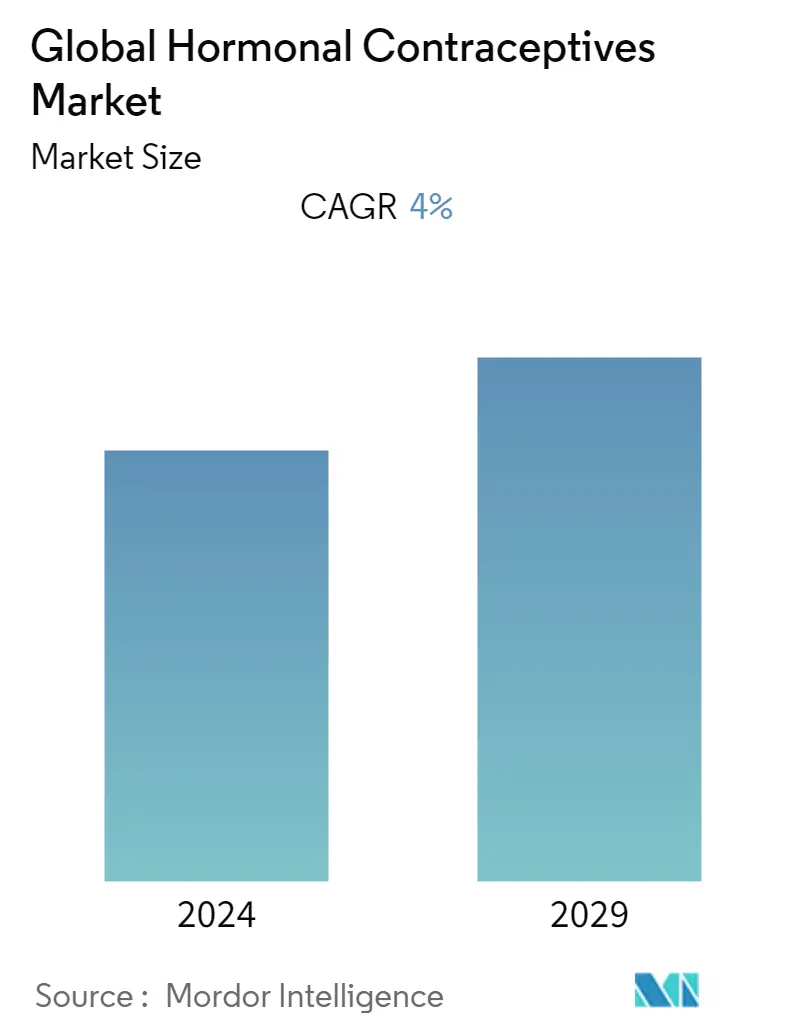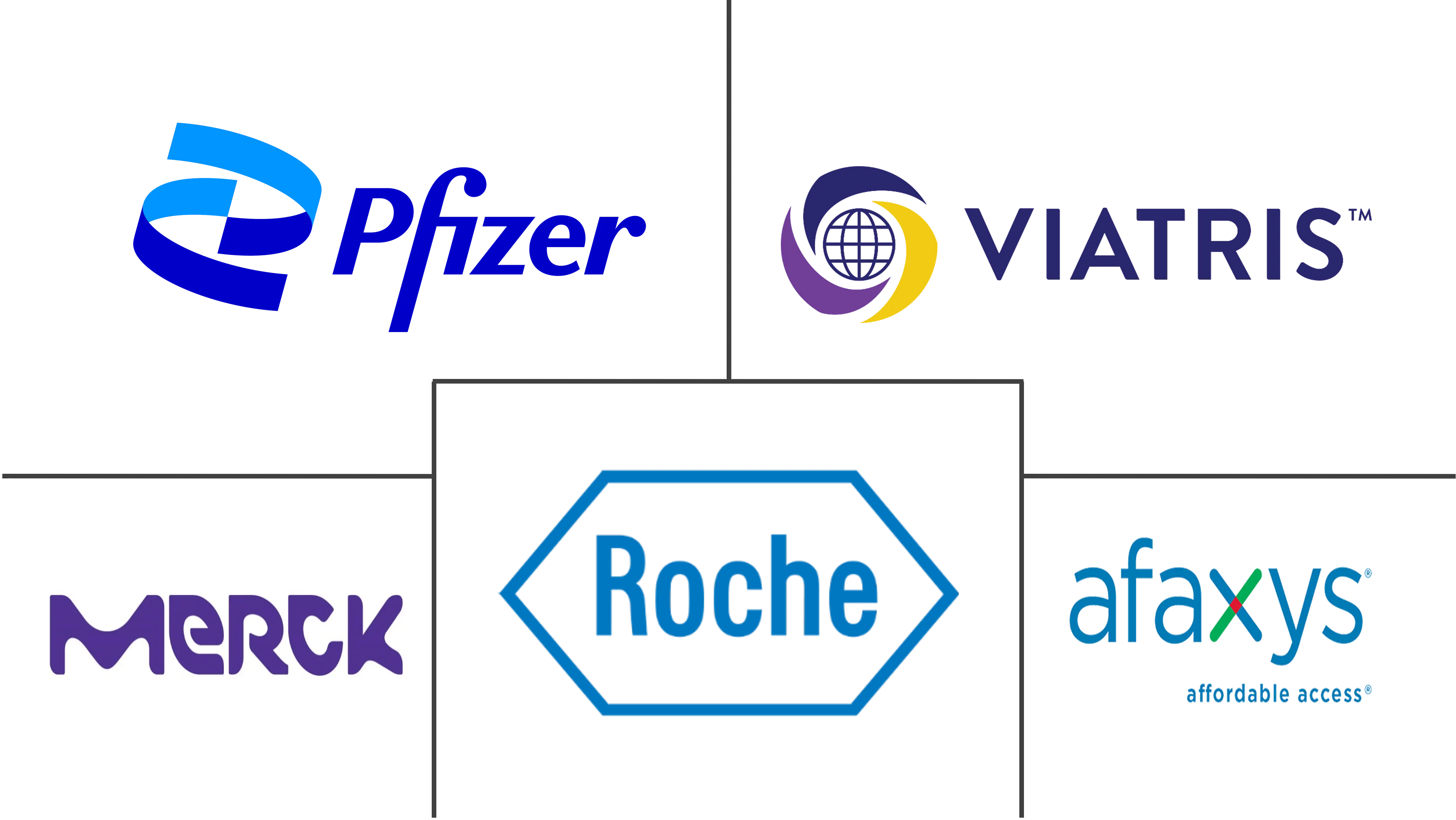
| Study Period | 2019 - 2029 |
| Base Year For Estimation | 2023 |
| Forecast Data Period | 2024 - 2029 |
| Historical Data Period | 2019 - 2022 |
| CAGR | 4.00 % |
| Fastest Growing Market | Asia Pacific |
| Largest Market | North America |
Major Players
*Disclaimer: Major Players sorted in no particular order |
Hormonal Contraceptives Market Analysis
The hormonal contraceptives market is poised to grow at a CAGR of 4% over the forecast period.
COVID-19 impacted the studied market. For instance, the article titled "Did COVID-19 Impact Contraceptive Uptake? Evidence from Senegal, West Africa" published in Studies in Family Planning in April 2022 stated that during the first wave of COVID-19 in March 2020, there was an immediate decrease in the number of new acceptors overall, and for new users of implants and injectables and oral contraceptive pills (OCPs). The overall trend in monthly new family planning acceptors increased from March - December 2020. Hence COVID-19 had an adverse impact in the beginning but as the situation worldwide normalized, the hormonal contraceptive market started to pace up.
In addition, increasing focus on family planning, favorable regulations by the government, and advancements in hormonal contraception are actively affecting the growth of the studied market.
The need to prevent unintended pregnancy and urbanization coupled with user awareness is projected to boost market growth over the forecast period. For instance, The Department of Economic and Social Affairs, World Fertility and Family Planning 2020 report, stated that globally, women have fewer babies, but fertility rates were high in some parts of the world. The 2030 Agenda for Sustainable Development has a goal that is pertinent to family planning and fertility under objective, which comprises a number of aims to protect the population's health and well-being. In accordance with Target 3.7, all people is likely to have access to family planning, informational and educational materials, and programs that incorporate reproductive health into national policies and plans by the year 2030. Thus, the awareness and government initiatives on family planning is likely to results in an increased demand of contraceptives, which is ultimately projected to boost the market.
Furthermore, the article titled "The United States Government and International Family Planning & Reproductive Health Efforts" published in Kaiser Family Foundation in November 2021 stated that worldwide, 218 million women have an unmet need for modern contraception. The high demand of contraceptive worldwide is anticipated to boost the market during the forecast period.
The company's efforts in producing innovative hormonal contraceptives and enhanced efficiency are anticipated to boost the usage of hormonal contraceptives in the near future. For instance, in April 2021, the Food and Drug Administration approved a combination of drospirenone and estetrol tablet Nextstellis marketed by Mayne Pharma for preventing pregnancy, one of the first combination pills containing naturally occurring estrogen. Such approvals are projected to augment the market growth.
Therefore, owing to the aforementioned factors the studied market is anticipated to witness growth over the analysis period. However, the availability of alternative contraceptive methods and health risks associated with hormonal contraception are likely to impede market growth.
Hormonal Contraceptives Industry Segmentation
As per the scope of the report, hormonal contraceptives are one of the birth control methods that act on the endocrine system. This includes using hormones such as progesterone and estrogen to prevent pregnancy by preventing ovulation. The report covers contraceptives that contain hormones, prevents ovulation and pregnancy, and maybe pharmaceutical or medical device. The Hormonal Contraceptive Market is segmented by Product (Oral Contraceptives, Skin Patches, Intrauterine Devices, Hormonal Implants, and Others), Hormone (Progestin Only and Combined Hormone Contraceptives), Distribution Channel (Hospital Pharmacies, Retail Pharmacies, and Others) and Geography (North America, Europe, Asia-Pacific, Middle East and Africa, and South America). The market report also covers the estimated market sizes and trends for 17 different countries across major regions, globally. The report offers the value (in USD million) for the above segments.
| Oral Contraceptives |
| Skin Patches |
| Intrauterine Devices |
| Hormonal Implants |
| Others |
| Progestin Only |
| Combined Hormone Contraceptives |
| Hospital Pharmacies |
| Retail Pharmacies |
| Others |
| North America | United States |
| Canada | |
| Mexico | |
| Europe | Germany |
| United Kingdom | |
| France | |
| Italy | |
| Spain | |
| Rest of Europe | |
| Asia-Pacific | China |
| Japan | |
| India | |
| Australia | |
| South Korea | |
| Rest of Asia-Pacific | |
| Middle-East and Africa | GCC |
| South Africa | |
| Rest of Middle-East and Africa | |
| South America | Brazil |
| Argentina | |
| Rest of South America |
Global Hormonal Contraceptives Market Size Summary
The hormonal contraceptives market is expected to experience steady growth over the forecast period, driven by increasing awareness and focus on family planning, supportive government regulations, and advancements in contraceptive technologies. The market initially faced challenges due to the COVID-19 pandemic, which temporarily reduced the uptake of contraceptives. However, as global conditions improved, the market began to recover. The demand for hormonal contraceptives is further bolstered by urbanization and the need to prevent unintended pregnancies, with government initiatives and international goals like the 2030 Agenda for Sustainable Development playing a significant role in enhancing access to family planning resources. Despite the presence of alternative contraceptive methods and potential health risks associated with hormonal contraception, the market is poised for growth, supported by innovations and regulatory approvals in contraceptive products.
Oral contraceptives are anticipated to hold a significant share of the market due to their ease of use and widespread availability. The North American region is expected to dominate the market, supported by a strong presence of industry players, robust healthcare infrastructure, and government initiatives promoting family planning and reproductive health. The competitive landscape of the hormonal contraceptives market is fragmented, with several global and regional companies like Allergan, Merck, and Pfizer holding substantial market shares. Recent product launches and regulatory approvals, such as the introduction of novel oral contraceptives and over-the-counter birth control pills, are expected to further drive market growth. These developments, coupled with ongoing efforts to raise awareness and improve access to contraceptive methods, are likely to sustain the market's expansion in the coming years.
Global Hormonal Contraceptives Market Size - Table of Contents
1. MARKET DYNAMICS
- 1.1 Market Overview
-
1.2 Market Drivers
- 1.2.1 Increasing Focus on Family Planning and Favorable Regulations by Government
- 1.2.2 Advancements in Hormonal Contraception
-
1.3 Market Restraints
- 1.3.1 Availability of Alternative Contraceptive Methods
- 1.3.2 Health Risks Associated With Hormonal Contraception
-
1.4 Porter's Five Force Analysis
- 1.4.1 Threat of New Entrants
- 1.4.2 Bargaining Power of Buyers/Consumers
- 1.4.3 Bargaining Power of Suppliers
- 1.4.4 Threat of Substitute Products
- 1.4.5 Intensity of Competitive Rivalry
2. MARKET SEGMENTATION (Market Size by Value - USD million)
-
2.1 By Product
- 2.1.1 Oral Contraceptives
- 2.1.2 Skin Patches
- 2.1.3 Intrauterine Devices
- 2.1.4 Hormonal Implants
- 2.1.5 Others
-
2.2 By Hormone
- 2.2.1 Progestin Only
- 2.2.2 Combined Hormone Contraceptives
-
2.3 By Distribution Channel
- 2.3.1 Hospital Pharmacies
- 2.3.2 Retail Pharmacies
- 2.3.3 Others
-
2.4 Geography
- 2.4.1 North America
- 2.4.1.1 United States
- 2.4.1.2 Canada
- 2.4.1.3 Mexico
- 2.4.2 Europe
- 2.4.2.1 Germany
- 2.4.2.2 United Kingdom
- 2.4.2.3 France
- 2.4.2.4 Italy
- 2.4.2.5 Spain
- 2.4.2.6 Rest of Europe
- 2.4.3 Asia-Pacific
- 2.4.3.1 China
- 2.4.3.2 Japan
- 2.4.3.3 India
- 2.4.3.4 Australia
- 2.4.3.5 South Korea
- 2.4.3.6 Rest of Asia-Pacific
- 2.4.4 Middle-East and Africa
- 2.4.4.1 GCC
- 2.4.4.2 South Africa
- 2.4.4.3 Rest of Middle-East and Africa
- 2.4.5 South America
- 2.4.5.1 Brazil
- 2.4.5.2 Argentina
- 2.4.5.3 Rest of South America
Hormonal Contraceptives Market Research FAQs
What is the current Global Hormonal Contraceptives Market size?
The Global Hormonal Contraceptives Market is projected to register a CAGR of 4% during the forecast period (2025-2030)
Who are the key players in Global Hormonal Contraceptives Market?
Allergan plc, Afaxys, Inc., Merck & Co., Inc., Pfizer Inc. and Mylan N.V. are the major companies operating in the Global Hormonal Contraceptives Market.


